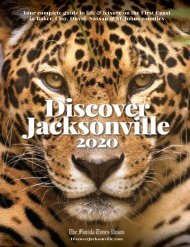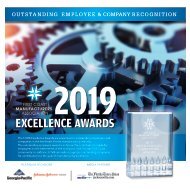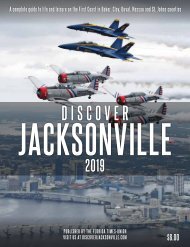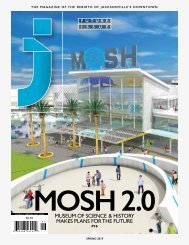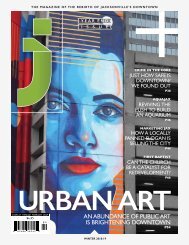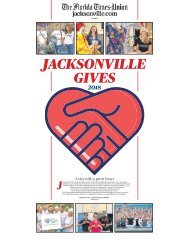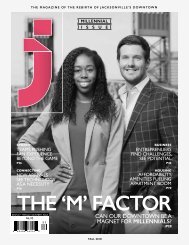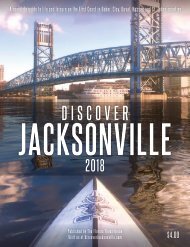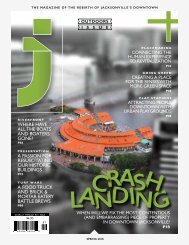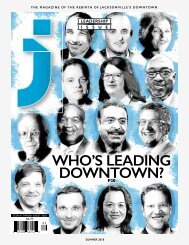J Magazine Winter 2019
You also want an ePaper? Increase the reach of your titles
YUMPU automatically turns print PDFs into web optimized ePapers that Google loves.
One of the unique aspects of Downtown is<br />
you’ve got people living in penthouses and you<br />
have people living on the streets and everything<br />
in between. You want to create a neighborhood<br />
and a culture around that. How do you do that?<br />
Dean Kate: Well, you create an attractive,<br />
beautiful space. You fill in the parking lots, half<br />
of our land is surface parking lot, which makes<br />
people feel insecure. I did a funeral three weeks<br />
ago and a woman in her 50s came to me and said<br />
she hadn’t been Downtown in 25 years because<br />
she was frightened to come Downtown. And most<br />
of that is myth. It’s not dangerous Downtown.<br />
The crime rate is not high, but there’s this sense of<br />
emptiness. So the first thing we need to do is fill in<br />
the gaps and build. And then, from a theological<br />
perspective in the Christian tradition, we believe<br />
that God is Trinity which is Father, Son and Holy<br />
Spirit, which is community. So, we’re called to<br />
build community, that’s what God wants for us.<br />
God doesn’t want people living in isolation.<br />
True community involves diversity. We learn<br />
from people who are different from us, who have<br />
different socio-economic experiences and races<br />
and cultures. So, our vision is to fill in the empty<br />
gaps with parks, trees, buildings. Build residential<br />
first and then retail and create some kind of<br />
economic and socio-economic diversity so that<br />
people can come to know each other. Get them<br />
out walking, get them out onto the streets. Right<br />
now the traffic is so fast on some of those thoroughfares<br />
that our elderly people push the button<br />
to walk across the street and they can’t get to the<br />
other side. It’s literally dangerous.<br />
And it’s also kind of an environmental issue<br />
as well. We want people back outside. We want<br />
some green space. Ginny has figured out a way to<br />
plant 100 trees. I particularly feel passionate about<br />
these elderly people. They can’t walk because it’s<br />
too dangerous, not in terms of crime but in terms<br />
of the speed of the traffic. Where do they go?<br />
Where is there grass or a garden? There’s nothing<br />
for them so then they get isolated, then they get<br />
depressed. And that’s not what we want.<br />
Ginny: Our master development plan has<br />
residential on Duval and Church. Right now those<br />
streets are one-way going the opposite direction.<br />
So if you can two-way those streets, you immediately<br />
slow down the traffic tremendously and<br />
create a neighborhood where you’ve got sidewalks<br />
capable of handling people on both sides. The city<br />
has done a pretty good job recently of putting in<br />
what I would refer to as temporary crossing places<br />
with a flashing light. There’s one right in front of<br />
FIS on Riverside Avenue. It says pedestrians are<br />
going across here, and everybody slows down for<br />
them. We’ve been talking about two-way streets<br />
Downtown for many, many years, and I’m hoping,<br />
[DIA CEO] Lori Boyer is on a fast track to do it.<br />
Another part of our mission is to develop a<br />
sense of a neighborhood, a sense of place. So to<br />
“What is<br />
about to burst<br />
open is what<br />
Shad Khan<br />
is going to<br />
do along the<br />
waterfront,<br />
which will<br />
require<br />
literally<br />
thousands of<br />
employees<br />
who are not<br />
capable of<br />
living in a<br />
high-end<br />
apartment or<br />
a high-end<br />
condo.”<br />
DEAN KATE<br />
MOOREHEAD<br />
that end, we have engaged Linda Crofton who’s<br />
come on our staff. Her first big event in December<br />
is called Christmas in the Cathedral District. All<br />
five churches are participating. It’s an evening<br />
event with different kinds of music, a street fair<br />
and food trucks.<br />
And then there’s a biking group that’s coming<br />
in the spring to Jacksonville for a big conference,<br />
and they asked if they could use a route in the<br />
Cathedral District. And we said, absolutely. So<br />
that’s going to be the second event where we bring<br />
the neighbors out.<br />
Dean Kate: We also want to utilize what we<br />
already have. St. John’s Cathedral is an architectural<br />
jewel that a lot of people have not been in. So<br />
we’re now doing regular art exhibits. We’ve got a<br />
lot more partnerships. We have a new bookstore<br />
in a home across the street from the Cathedral.<br />
We’re trying to utilize our space more. We’re<br />
doing more music events. So, we hope to just use<br />
this beautiful building for lots of different kinds of<br />
things, not just worship. We’re hosting Olivia’s Tea<br />
Party. It’s a nonprofit where they take homeless<br />
girls and throw a huge beautiful tea party for them<br />
and get them beautiful dresses and teach them<br />
etiquette. Just all these gorgeous things you can<br />
do in a Cathedral.<br />
Cathedrals are the traditional centers of a<br />
village with all kinds of diversity within it. That’s<br />
where universities were born. There were schools.<br />
There were hospitals. There was art and music. So,<br />
we’re really harkening back to something that’s<br />
very ancient, and worked for a long time.<br />
You all talked about some of the impediments to<br />
getting things done. What would you like to see<br />
to break through some of those impediments?<br />
Dean Kate: We should say that we’re thankful<br />
for the Jessie Ball du Pont Fund because without<br />
their help, I don’t know if we could have done<br />
all this. But we also think that city government<br />
should not be an obstacle to this kind of development.<br />
They should find a way to make it easier<br />
on us. Ginny has had to work really, really hard,<br />
and to jump through too many hoops. And if it<br />
wasn’t for the fact that we feel called by God to<br />
do this, we would never have been able to do it<br />
if we weren’t funded by du Pont, had a strong<br />
congregation and a real strong vision. We would<br />
have given up a long time ago. It shouldn’t be<br />
that hard. We should be all on the same team. I<br />
believe everyone wants this Downtown to thrive.<br />
We want the city to be a healthy city, to have a vibrant<br />
urban core. So how could we possibly make<br />
it easier on all the nonprofits, all the groups that<br />
are trying hard to make this city more beautiful<br />
and more vibrant? We could do a better job in<br />
process.<br />
LILA ROSS, a former news editor at the Times-Union,<br />
lives in San Marco.<br />
94<br />
J MAGAZINE | WINTER <strong>2019</strong>



